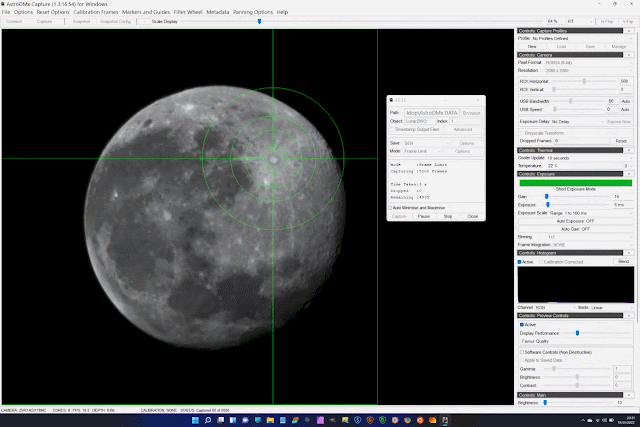Nicoloa has made a Feature-Release of AstroDMx Capture, Version 1.4.1.0 for Windows, macOS, Linux (including Raspberry Pi OS) and Chrome OS.
The reticle overlay can be very useful if you are manually guiding on the object, or using Region of Interest Nudge, to keep the Moon or planet in more or less the same position on the display, whilst a SER file is being captured.
Screenshots showing AstroDMx Capture for Windows displaying different reticle overlays and capturing 2000-frame lunar SER files with a ZWO ZWO ASI 178MC with a William Optics 66mm, f/5.9, APO, ED doublet refractor.
Complex reticle with crosshairs
A Cool Camera
Nicola has implemented a prototype of the latest camera from the SVBONY stable; the cooled SV405CC. This is a well built, set-point cooled, 14 bit OSC CMOS camera with a maximum resolution of 4144 x 2822 (12Mp) using the SONY IMX 294 sensor . We shall be bench-testing and field-testing the camera, and helping SVBONY to identify and rectify any SDK problems that may arise. So far, the camera is behaving quite well out of the box, with only a small number of problems that need to be addressed by the SVBONY software engineers. This is a versatile camera that will make it a true all round device, capable of set-point cooled OSC deep sky imaging as well as lunar and planetary imaging with the right scope. 1.25" or 2" scope adapters can be fitted to the camera for appropriate attachment to the telescope.
The SVBONY SV405CC
First Light
A short window of opportunity between showers and prompted the selection of quick setup equipment for the First Light field test of the SV405CC.
The SV405CC was placed at the focus of a 66mm, f/5.9, APO, ED doublet refractor mounted on an iOptron Cube Pro AZ GOTO mount.
Equipment used
AstroDMx Capture for Windows was used to capture 48 x 20s exposures with matching dark frames.
Screenshot of AstroDMx Capture for Windows capturing 20s FITS files of the Orion nebula
HiDPI
HiDPI (High dots per inch (dpi)) or (High pixels per inch (ppi)) monitors . In monitors the terms dpi and ppi are often used interchangeably, whereas dpi should really refer to the printed page. Here they are considered to be interchangeable and relating to monitor resolution.
HiDPI: There is no official dpi threshold for HiDPI monitors, but they have at least 200 dpi. A typical 27" monitor may have a resolution of 2560x1440 pixels (109 dpi). A HiDPI 27" monitor may have a resolution of 5120x2880, which is twice the pixel density (218 dpi). HiDPI involves a system of pixel doubling in a display and drawing an image with twice as many physical pixels in each direction as the number of virtual pixels required to draw the shape. This produces sharper images and better aliasing. HiDPI monitors are becoming more common, and the more recent Macs for example have HiDPI displays (Apple call these Retina displays). A number of other laptop manufacturers are also marketing machines with HiDPI displays.
AstroDMx Capture is now HiDPi aware and a problem associated with HiDPI monitors involving the image preview screen and scaling is now rectified.
KLOCs
The Scale of the AstroDMx Capture project:
The code for AstroDMx Capture is now about 70 KLOCs (Thousands of lines of source code, not including camera SDKs). There are also about 12,000 lines of internal documentation (making a total of 82,000 lines). Many lines require more than one physical line to contain them which means that in a sense, the above line numbers are smaller than the number of actual lines.
To put this in an understandable and realistic perspective I will use a method that I have used before:
The book 'iWoz', the autobiography of Steve Wozniak, co-founder of Apple, is a fairly typical book in terms of size, if not content. It has 30 lines of text per page and 342 pages.
Therefore, to hold all of the lines of source code and internal documentation in AstroDMx Capture would require at least 8 printed volumes, each the size of 'iWoz' to contain everything.
Computer code, in this case mainly C++ is by no means easy to read (even by the person who has written it) sometimes it can be many months or even years before a given segment of code is re-visited. Internal documentation comprises text within the code that explains how the code works so that the programmer can more easily understand the code and how it works. Adequate internal documentation is, therefore essential for the maintenance of any long-term coding project, particularly when it grows to the size of AstroDMx Capture.
In addition to the above; being multi-platform software, AstroDMx Capture has to be compiled for all of the separate operating systems: Windows, macOS, Linux (rpm and deb based systems), Raspberry Pi OS, 32bit and 64bit, and Chrome OS running the Crostini Linux environment.
Since it began in 2016, AstroDMx Capture has truly become a Magnum Opus and it takes Nicola a significant amount of time to push forward as well as discussing and planning for new features and how they can be implemented.










